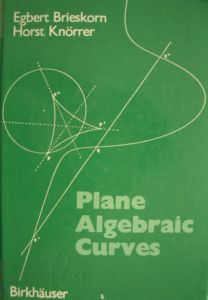Chapter 1 is a very exciting tour of algebraic curves through history with lots of examples and pictures. There is a wealth of examples already from Greek days. The two main systematising tools are analytic geometry (chapter 2) and projective geometry (chapter 3). Analytic geometry imposes a hierarchy on algebraic curves according to the degree of their equation. The pivotal case is the cubics. Newton carried out an algebraic classification of cubics into 72 cases, but he also noted that any cubic could be obtained from one of only five standard cases by central projection. A real theory of projective geometry, however, would have to wait until the 19th century and the realisation that the complex projective plane, realised by homogenous coordinates, is the proper setting for this theory. Thus we now have a clear algebraic basis for our theory so we now leave the historical perspective and start to develop the theory more systematically (chapters 4-6). With the basic machinery of polynomial algebra we can now treat properly some concepts we had seen in special cases (reducibility of curves, singular points) and some theorems we had only felt (Bézout's theorem, point-line duality). (Already here the authors sneak in some non-standard material (singularities as torus knots, topological proof of Bézout's theorem) to harmonise with the more modern theory later in the book.) In chapter 7 we see applications, in particular the showcase theorem on the configuration of the inflections points of a cubic, and the role of cubics elsewhere in mathematics (the addition-of-points operation makes them abelian manifolds and they are also the tori on which elliptic functions live). These were the nonsingular cubics. Now we shall study curves with singularities. This is an opportunity to include decidedly more modern work, and our authors get carried away in an enormous 250-page chapter 8 on the resolution of singularities. But in chapter 9 it's back to the classics, namely the basic formulae on global invariants. First the Plücker formulae. For a nonsingular curve of order n, the order of its dual curve is n(n-1) and the number of inflection points is 3n(n-2). When the curve has singularities one must add correction terms. Plücker found the correct formulae when the singularities are not worse than ordinary double points and simple cusps. Weierstrass and M. Noether generalised. Similarly for the genus of a curve. For nonsingular curves it's (n-1)(n-2)/2; Clebsch found the formula for when there are only easy singularities; M. Noether generalised. As Riemann knew, the genus is also the number of linearly independent integrals of the first kind, and we spend the last 70 pages expanding this function theoretic point of view.
In Collection
#281
Read It:
Yes
#281
Read It:
Yes
|
|
||||||||||||||||||
